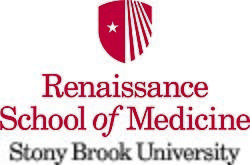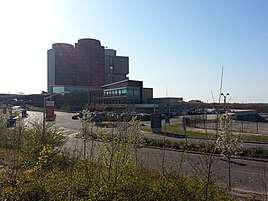Renaissance School of Medicine at Stony Brook University
The Renaissance School of Medicine is the medical school of Stony Brook University located in the hamlet of Stony Brook on Long Island, New York. Founded in 1971,[3] it is the top ranked public medical school in New York according to US News.[4] The School of Medicine conducts $90 million in funded medical research annually,[5] with NIH awards to the School of Medicine faculty and research centers exceeding $42 million.[6] The School of Medicine shares a campus with Stony Brook University Hospital.
 | |
| Type | Public |
|---|---|
| Established | 1971 |
Parent institution | State University of New York at Stony Brook |
| Dean | Kenneth Kaushansky |
Academic staff | 904 [1] |
| Students | MD - 564[2] |
| Location | Stony Brook , , United States |
| Website | stonybrookmedicalcenter |
History
Stony Brook University School of Medicine opened in autumn 1971. The inaugural class of 17 medical doctors graduated in 1974.[7] The first Dean of the School of Medicine was Edmund D. Pellegrino, MD.[8]
Stony Brook University School of Medicine was renamed the Renaissance School of Medicine at Stony Brook University on November 21, 2018.[9] This was done to acknowledge over $500 million in donations from employees of Renaissance Technologies, a hedge fund located 2 miles from the School of Medicine. The hedge fund was founded by Jim Simons (James Harris Simons), the former Stony Brook Mathematics Department Chair. The name change acknowledges not only the namesake of Simons' hedge fund, Renaissance Technologies, but also the "renaissance" in biomedical research and innovation that the donations have fueled. The donations have helped create 9 academic and research centers, endowed 34 chairs and professorships, and funded $35 million in scholarships and fellowships.[9]
Due to the COVID-19 Pandemic, the School of Medicine moved from in-person to online classes for the spring semester of the 2019–2020 academic year. After an executive order was signed by Governor Andrew Cuomo allowing for early graduation among senior medical students, 122 students from the class of 2020 graduated 2 months early, 63 of whom were deployed to the front lines of the pandemic within weeks.[10]
About
The School of Medicine consists of 8 basic science and 18 clinical Departments. The School of Medicine is involved in the preclinical and clinical education of students in the five schools of the Health Sciences, the students of public health, and students across other schools in the University. The School of Medicine provides graduate, post-graduate and continuing education degrees.[11]
The School of Medicine offers dual degrees in conjunction with other schools at Stony Brook University. Applicants may apply to the NIH funded MD-PhD Medical Scientist Training Program. Additionally, various dual degrees options may be pursued including an MD-MPH in conjunction with the School of Public Health, an MD-MBA in conjunction with the College of Business, and an MD-MA in conjunction with the Center for Bioethics, Compassionate Care and Medical Humanities.
MagicAid, a non-profit organization, was founded by medical students at the school in 2016.[12]
Curriculum
The School of Medicine has recently redesigned its curriculum, which has been renamed the LEARN (Learning, Experiential, Adaptive, Rigorous, and Novel) Curriculum. The curriculum is composed of three phases: (Foundational) Phase I, (Primary Clinical) Phase II, and (Advanced Clinical) Phase III. Phase I, which takes place over 18 months, begins with the 24 week "B3" course, which concerns anatomy, the molecular foundations of medicine, and mechanisms of disease. The following 36 weeks are a sequence of five integrated pathophysiology systems-based courses. Phase II, which is 12 months, marks the start of clinical clerkships, including pediatrics and ob-gyn, surgery, anesthesia and emergency medicine; and psychiatry, neurology and radiology. Finally, Phase III, totaling 16 months, includes a combination of sub-internships in medicine, pediatrics, surgery, emergency medicine, ob/gyn, or urology, advanced clinical experiences, transition to residency courses, selectives, and electives. Students are given a 10-week period between phases II and III to study and sit for the USMLE Step 1 Exam.[13]
In addition to the LEARN Curriculum, the School of Medicine offers a Scholarly Concentrations Program, which allows students to explore one of four academic concentrations, including Basic, Translational, Clinical and Social Sciences Research, Global Health, Medical Education, and Medical Humanities and Ethics.[14]
Accepted students who are already certain of the medical speciality the would like to pursue are invited to apply to the Three-Year MD Program. Depending on the specialty, between zero and two students from each incoming class are accepted to each specialty. The program saves students a year of schooling, as the curriculum is reduced from 149 weeks to 135 weeks. Students accepted into this program are given conditional acceptance to the residency program of their choice at the Renaissance School of Medicine.[15]
The School of Medicine also offers dual degree programs in affiliation with other Stony Brook University Schools and outside research institutions. Among them are the MD/MBA program in conjunction with the College of Business at Stony Brook University[16] and the MD/PhD program in conjunction with Cold Spring Harbor Laboratory and the Brookhaven National Laboratory.[17]
Affiliated Teaching Hospitals and Institutions

Residents and fellows of the School of Medicine train at 6 sites on Long Island:[18]
- Stony Brook University Hospital
- Stony Brook Children's Hospital
- Northport VA Medical Center
- Stony Brook Southampton Hospital
- Nassau University Medical Center
- South Nassau Communities Hospital
Additionally, the School of Medicine offers its students international rotations for residents in the Departments of Medicine, OB/GYN, Pediatrics, Anesthesiology and Emergency Medicine at various partner sites, including Chile, China, Ecuador, Japan, Madagascar, Peru, Rwanda and Uganda.[5]
In 2016, the School of Medicine entered into a strategic partnership with the Mount Sinai Health System and the Icahn School of Medicine in Manhattan.[1] This was done to increase collaboration in medical education, biomedical research, and delivery of care.
Research
Over $90 million in research is funded annually at the School of Medicine.[1]
Researchers at the School of Medicine have contributed to major medical innovations including:[1]
- MRI technology by Paul Lauterbur who was awarded the Nobel Prize in Physiology or Medicine
- PET scan technology
- 3D virtual colonoscopy
- Research that led to the discovery of etiology of Lyme disease
Drugs that were developed by faculty of the School of Medicine include:[1]
- Abciximab (for cardiac angioplasty)
- Doxycycline (for periodontal disease)
- Collagenase clostridium histolyticum (for Dupuytren's disease)
Selectivity and ranking
In 2018, the School of Medicine received over 4,800 applications for 136 seats. The incoming class had an average GPA of 3.8 and MCAT score of 513, which is the 90th percentile nationally.[19] In New York, it is the top ranked public medical school.[20] Nationally, it is ranked 58th in Research and 84th in Primary Care by U.S. News & World Report.[4] The school has a 98% pass rate on the United States Medical Licensing Examination (USMLE) Step 1.[19] Among graduates, one in four have matched to a top 20 medical residency program.[19]
References
- "Renaissance School of Medicine at Stony Brook University: Fact Sheet -". SBU News. 21 November 2018.
- http://grad-schools.usnews.rankingsandreviews.com/best-graduate-schools/top-medical-schools/school-of-medicine-04077#
- "History - Renaissance School of Medicine at Stony Brook University". renaissance.stonybrookmedicine.edu.
- "Ranking". grad-schools.usnews.rankingsandreviews.com. Retrieved 2019-06-29.
- says, Nancy Lustig (2018-11-21). "Renaissance School of Medicine at Stony Brook University: Fact Sheet |". SBU News. Retrieved 2020-06-21.
- "NIH Awards by Location and Organization - NIH Research Portfolio Online Reporting Tools (RePORT)". report.nih.gov.
- "SBU: History and Timeline: Timeline: 1970-1974". Stony Brook University Libraries.
- Nyitray, Kristen (July 9, 2013). "Remembering Stony Brook's Health Sciences Founder, Dr. Edmund D. Pellegrino". Stony Brook University Libraries.
- "A Renaissance for Stony Brook's School of Medicine -". SBU News. 21 November 2018.
- says, Francis Boadi (2020-04-08). "Med Students Graduate Early to Join Frontlines of Pandemic Emergency |". SBU News. Retrieved 2020-06-21.
- http://www.stonybrookmedicalcenter.org/som/admissions#uhmc%5B%5D
- America, Good Morning. "Ian Dowling is a 10-year-old cancer survivor who believes in magic". Good Morning America. Retrieved 2020-03-28.
- "The Curriculum | Renaissance School of Medicine at Stony Brook University". renaissance.stonybrookmedicine.edu. Retrieved 2020-06-21.
- "Scholarly Concentrations Program | Renaissance School of Medicine at Stony Brook University". renaissance.stonybrookmedicine.edu. Retrieved 2020-06-21.
- "The Three-Year MD Program at The Renaissance School of Medicine at Stony Brook University | Renaissance School of Medicine at Stony Brook University". renaissance.stonybrookmedicine.edu. Retrieved 2020-06-21.
- "MD/MBA | College of Business". www.stonybrook.edu. Retrieved 2020-06-21.
- "Medical Scientist Training Program | Renaissance School of Medicine at Stony Brook University". renaissance.stonybrookmedicine.edu. Retrieved 2020-06-21.
- "Medical Education - Renaissance School of Medicine at Stony Brook University". renaissance.stonybrookmedicine.edu.
- "Admissions - Renaissance School of Medicine at Stony Brook University". renaissance.stonybrookmedicine.edu.
- "Facts - Renaissance School of Medicine at Stony Brook University". renaissance.stonybrookmedicine.edu.